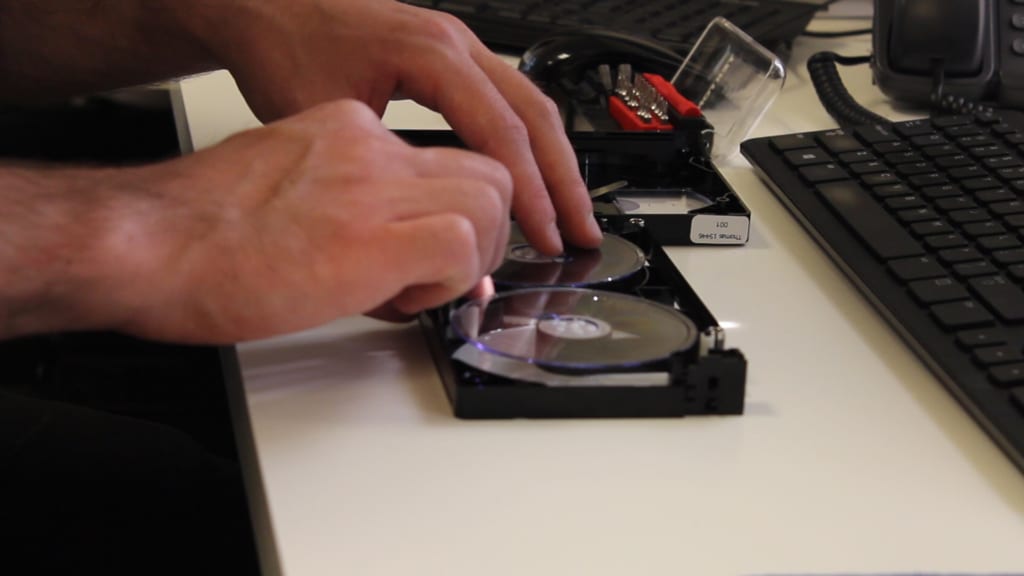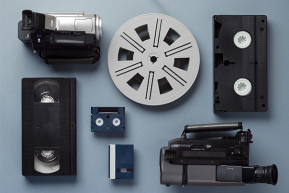Clients bring us video tapes in all shapes, sizes and conditions. We can almost always convert any given tape to digital, but sometimes it takes special equipment or extra work from our team. When tapes come in damaged in some way that prevents a high fidelity playback, we can usually solve the problem. Here are five of the most common problems for old tapes as well as the repair method we use to correct the issue:
1. Magnetic Tape Deterioration:
This is an issue with the magnetic tape itself, and can’t be repaired directly. The damage isn’t usually severe and causes the image on the screen to become shaky and unstable; occasionally thin lines appear on the screen. In more moderate presentations, the video tapes are still perfectly watchable despite the deterioration. In more severe cases, ‘frame hold’ can occur. The image will jump around the screen with black bars in between. In order to mitigate the effects of deterioration, we have a few different video tape decks we use during our digital conversion process. If we don’t get a good capture the first time around, we can usually get something by the second or third.
2. Tape Crease Error:

As the name suggests, Tape Crease error occurs when the magnetic tape has been creased or banged up. This frequently occurs with tapes that have become stuck in a VCR. Tape Crease error causes the playback of the tape to distort. Oftentimes, a horizontal smear will appear at the top of the screen. VHS-C tapes are particularly susceptible to Tape Crease Error; they are generally looser and more fragile than the other tape formats. Additionally, certain VHS-c adapters may also cause some damage to the tapes, especially with prolonged use. Unfortunately, there is rarely anything we can do to reverse the effects of a tape crease, but fortunately, the crease does not usually spread to other parts of the tape over time. It is usually confined to only one area.
3. Digital Corruption:
Digital Corruption is a tricky one. It only appears on newer video cassettes like Digital 8 tapes and mini DVs. Unfortunately, we are never able to fully recover the lost footage from this type of damage. It usually occurs at the time of the capture, and as a result some of the footage isn’t captured at all. We also see this kind of distortion as a result of a deterioration of the magnetic tape. In severe cases, digital corruption results in a complete loss in audio and a heavy pixilation of the image. Typically we don’t see this throughout an entire tape and thankfully it is a rarity for a tape that we digitize to display digital corruption.

4. Standard Splice:
This is our most straightforward repair, and we always get something that is watchable afterwards. When a part of the video tape snaps due to it being fragile or brittle, we can re-attach the two pieces and continue with the digital transfer. Splices are the most common repair that we do and also the least damaging overall. Often, after we splice a tape, the only result is a barely noticeable blip in the image between the two pieces of tape.
5. Tape Slippage:
This is a less common problem with video tapes but it can be really irritating. Tape Slippage creates instances of skipping throughout all or part of a video tape. Tape slipping can be caused by two different factors: tape tension loss or tape warping. Tape tension is a common issue to impact VHS tapes, and can occur in storage. We exercise all tapes before digitizing to minimize tension issues, but some tapes can require additional attention to eliminate the issue. Tape warping is a dramatically different problem, when the tape itself starts to stretch or bend causing capture issues. This issue can occasionally be improved with a very intensive repair, but the improvement is often minimal. In these instances, we can actually unwind and re-spool the entire videotape in order to alleviate the issue.
All of the repairs that can be done on issues that affect the quality tape are to the physical tape itself, rather than the digital file. Many people are surprised by this. While there are sometimes things we can do to the digital file to improve the quality of a playback, by far the greater factor in the quality is the condition of the video tape itself. If you have any broken tapes, or you have experienced some of the issues mentioned above and want to know more, don’t hesitate to give us a call at 617-505-1132 or email us at [email protected].

